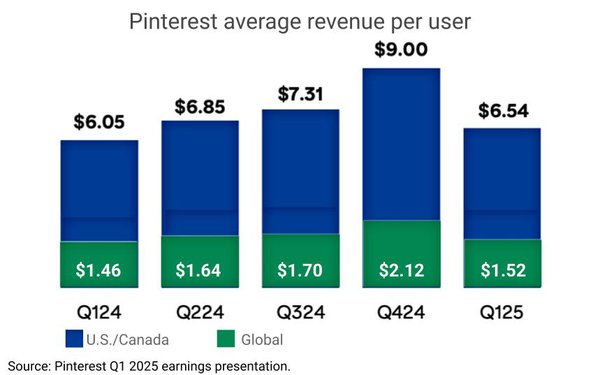
Pinterest reported its first quarter revenue
this week, following similar results
trends compared to some of its social media competitors and ultimately boosting both revenue and its user base.
In Q1 2025, Pinterest added 17 million monthly active users, raising its total base to about 570 million MAUs. The increase highlights the company’s ability to
continue appealing to more people in all markets, with its “Rest of the World” sector growing slightly more this past quarter than Europe or North America.
Still, this quarter marks its greatest growth numbers in the past five quarters, adding 1 million more users in
the U.S. and Canada, 3 million more users in Europe and 13 million more users in other regions, marking a 10% increase globally year-over-year and a 4% rise in North America.
advertisement
advertisement
Compared to last quarter -- Pinterest’s first-ever $1 billion quarter -- Q1
saw lower increases in revenue per user, with $6.54 per user in North America, compared to $9 in Q4 2024. However, the company’s average revenue per user is still up year-over-year in every
market and 5% globally.
Overall, the company brought in $855 million in Q1, marking a 16% rise
year-over-year globally and a 12% rise in North America. The platform is more than doubling that revenue growth in other regions as well, reporting 24% revenue growth in Europe and 49% in other
markets – India and Japan being among the most promising new markets for the platform.
The day after Pinterest released its revenue report, the company
announced a new partnership with Magnite, an online advertising firm that will become Pinterest’s sole supply-side platform. According to Pinterest CEO Bill Ready, Magnite will help the company
“aggregate smaller sources” in regard to advertising opportunities, ultimately connecting the company with more brands.
Pinterest attributes its positive quarterly results to its addition of more AI-powered ad tools, including its Performance+ suite
and in-stream discovery features, which Ready says are helping users “make more intentional shopping decisions.”
Notably, Pinterest
also reported seeing enhanced interest from financial services marketers.